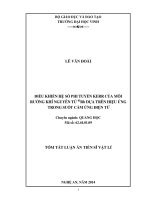Section 3 1 TRƯỜNG ĐIỆN TỪ
Bạn đang xem bản rút gọn của tài liệu. Xem và tải ngay bản đầy đủ của tài liệu tại đây (97.42 KB, 16 trang )
Slide Presentations for ECE 329,
Introduction to Electromagnetic Fields,
to supplement “Elements of Engineering
Electromagnetics, Sixth Edition”
by
Nannapaneni Narayana Rao
Edward C. Jordan Professor of Electrical and Computer Engineering
University of Illinois at Urbana-Champaign, Urbana, Illinois, USA
Distinguished Amrita Professor of Engineering
Amrita Vishwa Vidyapeetham, Coimbatore, Tamil Nadu, India
3.1
Faraday’s Law and
Ampère’s Circuital Law
3.1-3
Maxwell’s Equations in Differential Form
Why differential form?
Because for integral forms to be useful, an a priori
knowledge of the behavior of the field to be
computed is necessary.
The problem is similar to the following:
If
1
0 y(x) dx 2, what is y(x)?
There is no unique solution to this.
3.1-4
However, if, e.g., y(x) = Cx, then we can find y(x),
since then
1
x 2 1
0 Cx dx 2 or C 2 0 2 or C 4
y(x) 4x.
On the other hand, suppose we have the following
problem:
dy
If
2, what is y?
dx
Then y(x) = 2x + C.
Thus the solution is unique to within a constant.
3.1-5
FARADAY’S LAW
First consider the special case
E E x (z,t) a x and H H y (z, t) a y
and apply the integral form to the rectangular path
shown, in the limit that the rectangle shrinks to a
point.
y
z
(x, z)
x
z (x, z + z)
S
C
(x + x, z) (x + x, z + z)
x
3.1-6
d
C E d l dt S B dS
Ex z
z
d
By x z
x Ex z x
x,z
dt
E
Lim
x z z
x 0
z 0
Ex z x
x z
d
Lim
x 0
z 0
By
Ex
z
t
B
dt
y
x, z
x z
x z
3.1-7
General Case
E E x (x, y, z,t)a x E y (x, y, z,t)a y Ez (x, y, z, t)a z
H H x (x, y, z,t)a x H y (x, y, z,t)a y Hz (x, y, z, t)a z
Ez E y
Bx
–
–
y
z
t
By
E x E z
–
–
z
x
t
E y E x
Bz
–
–
x
y
t
Lateral space
derivatives of the
components of E
Time derivatives of
the components of B
3.1-8
Combining into a single differential equation,
ax ay az
x
Ex
y
Ey
B
–
z
t
Ez
B
E –
t
Differential form
of Faraday’s Law
a x
ay
az
x
y
z
B
Del Cross E or Curl of E = –
t
3.1-9
AMPÈRE’S CIRCUITAL LAW
Consider the general case first. Then noting that
d
C E • dl – dt S B • dS
E – (B)
we obtain from analogy,
t
d
C H • dl S J • dS dt S D • dS
H J (D)
t
3.1-10
D
H J
t
Thus
Special case:
E E x (z,t)a x , H H y (z,t)a y
ax a y az
D
0
0
J
z
t
0 Hy 0
H y
Dx
–
Jx
z
t
Differential form
of Ampère’s
circuital law
3.1-11
H y
Dx
– Jx –
z
t
8
Ex. For E E0 cos 6 ×10 t kz a y
in free space 0 , 0 , J = 0 ,
find the value(s) of k such that E satisfies both
of Maxwell’s curl equations.
Noting that E E y (z,t)a y , we have from
B
E – ,
t
3.1-12
ax
ay
az
z
0
B
– E – 0
0
t
0 Ey
Bx Ey
t
z
8
E0 cos 6 10 t kz
z
kE0 sin 6 108 t kz
kE0
8
Bx
cos
6
10
t kz
8
6 10
3.1-13
Thus,
kE0
8
B
cos
6
10
t kz ax
8
6 10
B
B
H
0 4 10 7
kE0
8
cos
6
10
t kz ax
2
240
Then, noting that H H x (z,t)a x , we have from
D
H ,
t
3.1-14
ax
D
× H 0
t
Hx
ay
0
0
az
z
0
Dy H x
t
z
2
k E0
8
sin
6
10
t kz
2
240
3.1-15
k 2 E0
8
Dy
cos
6
10
t kz
3
8
1440 10
k 2 E0
8
D
cos
6
10
t kz a y
3
8
1440 10
D
D
E 9
0 10 36
k 2 E0
8
2 cos 6 10 t kz a y
4
3.1-16
Comparing with the original given E, we have
k 2 E0
E0 2
4
k 2
E E0 cos 6 108 t 2 z a y
Sinusoidal traveling waves in free space, propagating in the
z directions with velocity, 3 10 8 (c) m s.









